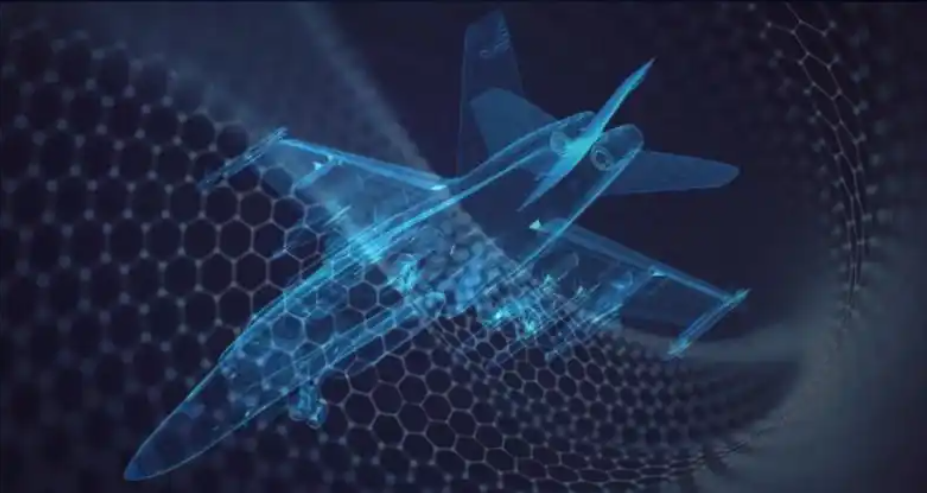Graphene in Aerospace Applications: Lightweight, Strong, and Smart
🚀 Introduction: Advanced Materials for a High-Altitude Future
In aerospace, performance, weight, and safety are tightly interconnected. Every kilogram saved can translate into significant fuel savings, increased payload, or longer flight range. At the same time, materials must withstand extreme temperatures, radiation, vibration, and corrosion over extended periods.

Graphene, with its ultra-lightweight, high mechanical strength, and exceptional conductivity, is emerging as a transformative material in aerospace engineering—not just enhancing performance but enabling smart functionalities.
🧩 Section 1: Key Aerospace Challenges Graphene Can Address
| Aerospace Need | Graphene Contribution |
|---|---|
| Weight reduction | One-atom-thick and stronger than steel |
| Thermal management | Conductivity > 3000 W/mK |
| EMI shielding | Absorbs and reflects electromagnetic radiation |
| Structural strength | Tensile strength >130 GPa |
| Smart functionality | Sensing, energy storage, self-healing |
| Corrosion resistance | Chemically inert and protective |
From fuselage panels to satellite components, graphene’s multifunctionality is being explored to solve multiple issues with a single material.
✈️ Section 2: Graphene-Enhanced Lightweight Composites
Weight is critical in aviation and space. Carbon fiber composites are widely used, but integrating graphene improves:
-
Interlaminar strength and delamination resistance
-
Fracture toughness
-
Fatigue resistance under cyclic loads
-
Thermal stability at high altitudes
Example:
-
Graphene-epoxy composite
-
20–30% improvement in flexural strength
-
50% higher thermal conductivity
-
Lower resin content needed (weight reduction)
-
Such composites are already under evaluation for unmanned aerial vehicles (UAVs), helicopter rotor blades, and internal structural components.
🌡️ Section 3: Thermal Management at High Altitudes and in Space
Spacecraft and high-speed aircraft face severe thermal gradients, where materials must:
-
Dissipate heat from engines or sun exposure
-
Maintain electronics within safe temperature ranges
Graphene helps by:
-
Serving as a heat spreader in composite laminates
-
Acting as thermal interface material (TIM) in avionics
-
Protecting surfaces via rGO or graphene oxide coatings
Use Case:
-
Graphene-enhanced carbon composites reduce surface temperature rise by up to 40%
-
Prevent hotspots in high-performance computing systems onboard satellites
📡 Section 4: EMI Shielding and Radiation Protection
As aircraft and spacecraft become more electronic, electromagnetic interference (EMI) becomes a growing threat to operational reliability. Graphene provides a lightweight and effective alternative to traditional metal shielding:
| Property | Performance |
|---|---|
| Shielding Effectiveness | > 40–60 dB in 8–12 GHz range |
| Weight | ~5x lighter than aluminum foil |
| Corrosion resistance | Excellent |
| Form factors | Paints, foils, composite layers |
Also, graphene’s atomic density makes it useful for radiation shielding, particularly in low-earth orbit satellites and deep-space probes.
🔬 Section 5: Sensing and Smart Materials
Graphene’s sensitivity to strain, temperature, and chemical environments enables the creation of smart aircraft components:
-
Structural health monitoring (SHM)
-
Strain-sensing coatings
-
Piezoelectric-actuated control surfaces
-
Graphene-based RFID or tag sensors
This leads to predictive maintenance, reduced inspection costs, and increased safety margins.
🌍 Section 6: Applications in Aircraft and Spacecraft
| Application | Graphene Role | Benefits |
|---|---|---|
| Cabin structures | Graphene-polymer panels | Lighter, fire-resistant |
| Leading edges | Graphene-epoxy composites | Thermal, erosion resistance |
| Avionics housing | EMI shield coatings | Lighter, conductive |
| Satellite panels | Graphene thermal layers | Uniform heat dispersion |
| Structural parts | Graphene-carbon fiber hybrid | Tough, crack-resistant |
| Interior paints | Graphene additives | Antistatic, self-cleaning |
Even future hypersonic vehicles and urban air mobility systems (UAM) are exploring graphene for multifunctional composite skins.
🧱 Section 7: Integration and Processing at Scale
To suit aerospace fabrication methods, graphene must be delivered in compatible forms:
-
Graphene oxide (GO) dispersions for matrix integration
-
Reduced graphene oxide (rGO) coatings for EMI shielding
-
Dry graphene powder for composite prepreg formulation
-
Masterbatches with epoxy or thermoplastics
GrapheneRich offers solutions designed for aerospace R&D labs and Tier 1 manufacturers, including stable dispersions and functionalized graphene suitable for vacuum infusion, autoclaving, or additive manufacturing.
🧪 Section 8: Case Studies and Test Results
Graphene-Carbon Fiber Composite
-
Tensile strength ↑ 25%
-
Impact energy absorption ↑ 30%
-
Fatigue life ↑ 2x
-
Weight ↓ ~10%
Graphene-Polymer EMI Paint
-
Shielding effectiveness: 55 dB (X-band)
-
Thickness: < 0.3 mm
-
Salt-spray corrosion resistance: > 500 hours
Thermal Interface Material (TIM)
-
rGO film (60 μm)
-
Reduces heat sink temperature by ~15°C
🔧 GrapheneRich Aerospace Solutions
Our offerings include:
🌫️ GO/rGO dispersions
-
For infusion, spray or spin-coating
-
Stable in water or alcohols
-
Custom flake sizes for EMI or thermal applications
🔩 Dry graphene powder
-
For composite integration
-
Surface-modified for epoxy compatibility
🎓 Consultation services
-
Formulation optimization
-
Lab-to-line support
-
Collaborative testing with aerospace partners
🌌 Conclusion: Elevating Aerospace with Atom-Thin Innovation
Graphene is no longer a laboratory curiosity—it’s an essential multifunctional material that addresses weight, strength, heat, and electronic integration in aerospace systems.
As flight platforms evolve toward smarter, lighter, and greener missions, the adoption of graphene will play a key role in building resilient, high-performance vehicles for Earth, orbit, and beyond.
✈️ Ready to integrate graphene into your next aerospace breakthrough?
Connect with GrapheneRich NanoTech to explore materials, samples, and design consultation.

